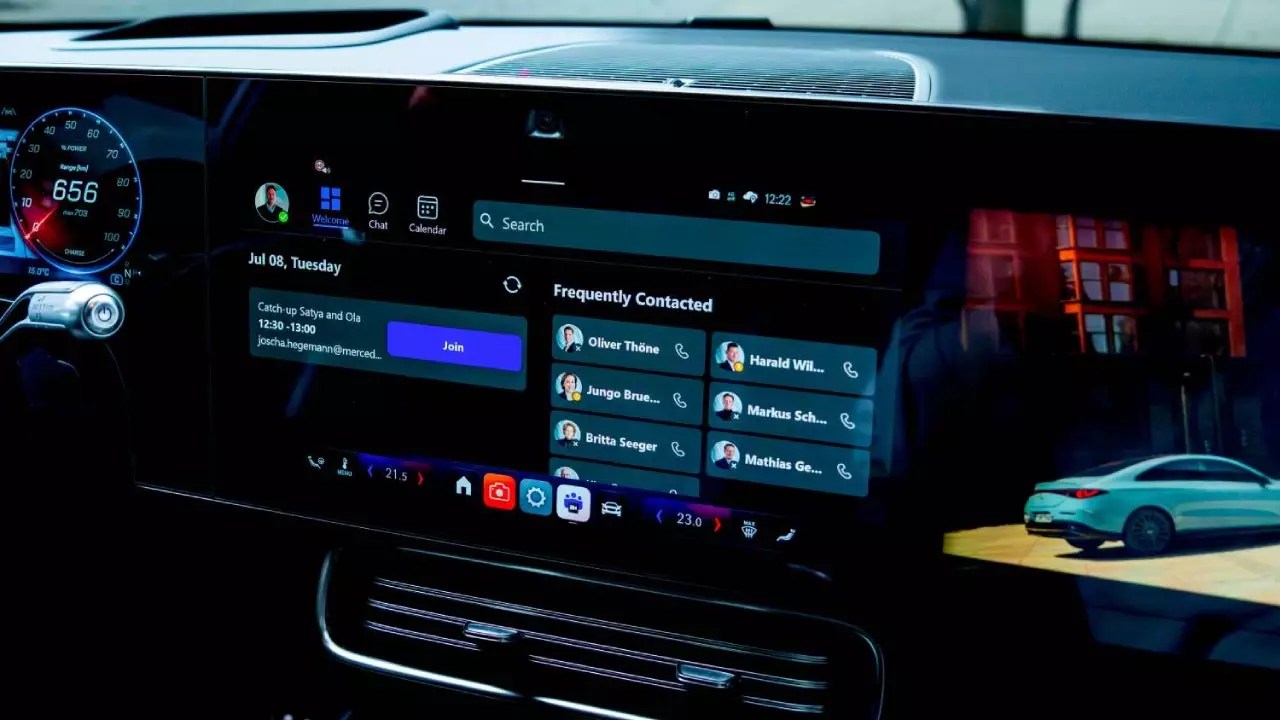Mercedes-Benz’s latest update represents a daring leap into integrating work-life seamlessly into the driving experience. By enabling live video feeds from in-car Teams meetings, the luxury automaker aims to cater to the modern professional’s relentless drive to stay connected, no matter where they are. This move underscores an evolving trend: the blurring of boundaries between work and personal life, often to the detriment of safety and focus. While the concept of being able to attend meetings from the comfort (or chaos) of a moving vehicle seems convenient on paper, it invites a series of critical questions about the true value and implications of such technological innovations.
At the core of this update is a feature that allows drivers to activate an in-car camera during a meeting, providing colleagues with a live view of them behind the wheel. Reportedly framed as a safety-conscious feature, it limits video streaming to the driver’s perspective, with the camera automatically turning off to prevent distraction. Yet, this autonomy raises eyebrows. Is this merely a clever marketing ploy to showcase cutting-edge tech, or does it subtly endorse a culture that tolerates multitasking behind the wheel? The answer hinges on one’s perspective: for some, it’s just about showing commitment, for others, a potential recipe for distraction.
Mercedes’s reassurance that the camera feed automatically disables when the vehicle is in motion and that the driver cannot see others’ faces might seem reassuring. However, it doesn’t eliminate the fundamental risk: the temptation to engage or caregiver visually or manually while driving. It’s a high-wire act between technological innovation and the primal need for safety. The assumption that drivers will use such features responsibly is optimistic at best; history suggests that when convenience or status is at stake, humans often find ways to push boundaries.
The Paradox of Practicality Versus Actual Usefulness
Beyond the controversial live video feature, Mercedes’s broader support for in-car Teams functionalities offers tangible benefits that strike a more practical tone. Features such as quick access to upcoming meetings and contacts, along with expanded chat functions and voice controls, are undeniably valuable. They promise to streamline workflows, reduce distraction, and make daily scheduling more manageable—all within a comfortable, connected environment.
The integration of voice commands to initiate, join, or navigate Teams meetings aligns with the ongoing shift toward hands-free technology—an essential development for safety and efficiency. Yet, this technological sophistication might be overshadowed by the superficial allure of live video streaming from a moving car. While such features might impress at industry shows or executive suites, their real-world utility remains questionable. Is it even feasible to conduct meaningful meetings while driving, particularly when considering varying conditions, legal restrictions, and the potential for human error? The practicality of multitasking in a vehicle, even with advanced safety measures, is inherently questionable.
What stands out most is how this innovation emphasizes the increasing normalization of performing complex tasks amidst the chaos of daily life. Nevertheless, it risks normalizing recklessness, subtly encouraging drivers to see their vehicle as a mobile office rather than a place primarily for safe travel. This shift could have consequences far beyond individual safety, impacting public perceptions of driving responsibility.
The Ethical and Safety Dilemmas of Innovation
Perhaps the most provocative aspect of Mercedes’s announcement is their bold introduction of generative AI capabilities through Microsoft 365 Copilot. This AI-enhanced assistant aims to help drivers prepare for meetings, summarize emails, and retrieve important client data—all through voice prompts. The promise of such innovation is alluring: a sci-fi vision of a vehicle that not only transports but also actively manages professional productivity.
Yet, this progress is shadowed by a critical question: how reliable are these AI tools in high-stakes environments? AI models, while impressive, are not infallible. They can misinterpret commands, provide inaccurate data, or malfunction at crucial moments—all of which could have serious consequences when on the road. Relying on these systems could foster overconfidence, potentially leading to distracted driving, decision fatigue, or worse.
Moreover, the ethical dilemma extends beyond technical reliability. By integrating such advanced AI features, Mercedes may unintentionally send a message that driving—an inherently risky activity—can be optimized to serve work obligations at all costs. The notion that routine daily tasks can be seamlessly managed in transit ignores the inherent risks associated with multitasking at high speeds, especially in unpredictable traffic conditions. While the technology might offer convenience, it seems to undermine the fundamental safety principles that have long governed vehicle operation.
In the final analysis, Mercedes’s initiative epitomizes a clash between ambitious technological progress and the enduring need for safety and responsibility. While the features presented are undoubtedly impressive and indicative of a future where cars are smarter and more integrated than ever before, they provoke a critical reflection on what the pursuit of innovation should truly prioritize: convenience and status or safety and human dignity.


Leave a Reply